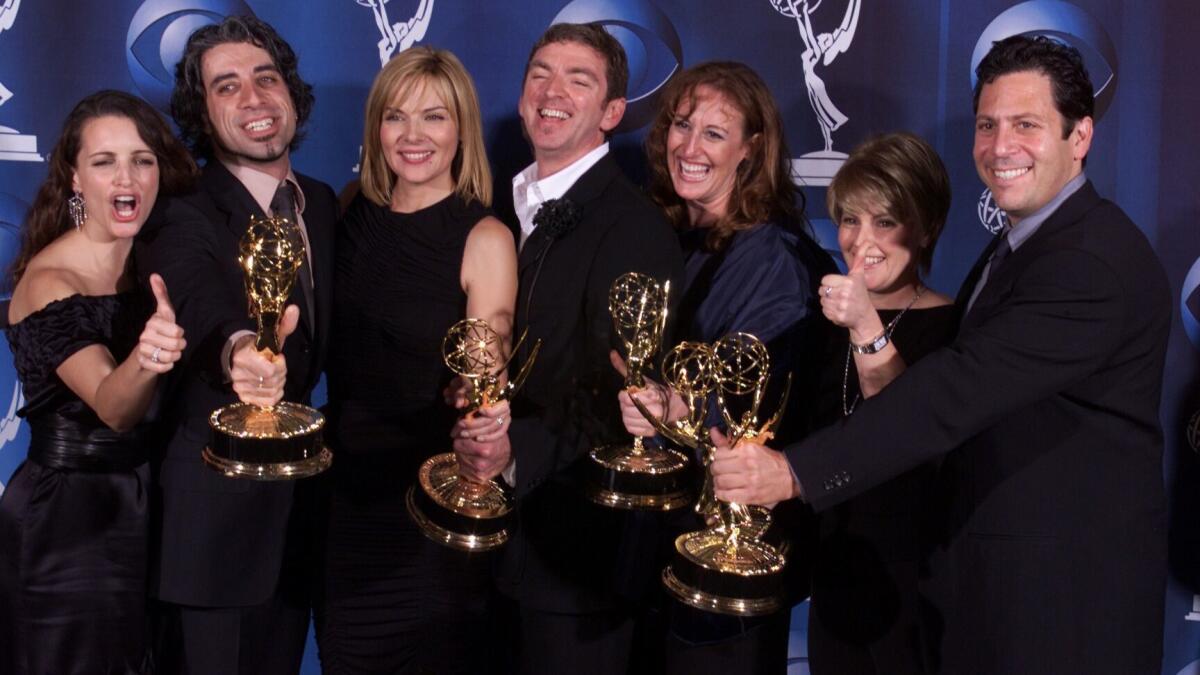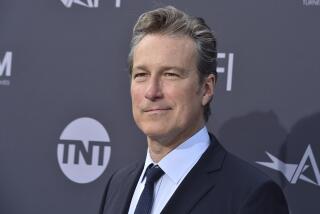Must Reads: ‘Sex and the City’ turns 20: How the HBO series revolutionized TV and dating forever
Twenty years ago, it all started with a female voice.
“Once upon a time,” she began, invoking a happily ever after that never came as she told a story of love and loss for a woman new in town and full of bright hopes, only to see them dashed by the whims of an undeserving man and, by extension, life in the big city.
But life went on, taxis kept rolling by and a new chapter in television began with a declaration of intent:
“Welcome to the age of un-innocence,” says Carrie Bradshaw, writing at home at night in view of New York City neon, “No one has breakfast at Tiffany’s, and no one has affairs to remember.”
Clearly, this was no fairy tale. But as telegraphed by its bouncy, marimba-laced opening theme, “Sex and the City” wasn’t a tragedy either. Launching in 1998, the groundbreaking HBO comedy followed Carrie (Sarah Jessica Parker), Miranda (Cynthia Nixon), Samantha (Kim Cattrall) and Charlotte (Kristin Davis) through the roller coaster of modern sexual entanglements and relationships for six seasons.
Even when the show ended in 2004, the hunger for more misadventures didn’t. “Sex and the City” later burst onto the big screen with two movies (one good, one less so). Plans for a third film recently fizzled (more on that later).
“I think one of the things that made this show vibrate for the audience is it was so personal to their experience,” said Michael Patrick King, one of the series’ executive producers and co-writer. “And that’s because we were all having the same experiences of trying to figure out who to be as single people in a world where society basically says you’re a leper.”
Far from a pre-millennium repurposing of the airy adventures of four Holly Golightlys, “Sex and the City” transformed the relationship columns of New York Observer columnist Candace Bushnell into a series that trounced television formulas about sex and love. It also kicked its designer heels at the boundaries of comedy with a ribald sense of honesty and what remains a comparatively rare thing on television: a woman’s perspective.
“When I was writing the column, the reality of a single woman in her 30s was a new idea,” Bushnell said in a phone call last week. “It was kind of revolutionary in the sense that this was a funny woman. I reread the book [collecting her columns, first published in 1997], and it’s really about female humor and the bawdiness of women. It seems like a common thing, but back then it was new. There weren’t TV shows about women. There was ‘Friends,’ but that was something entirely different.”
The series was created by writer-producer Darren Star, who up until that point had been behind the network dramas “Beverly Hills: 90210,” “Melrose Place” and, less successfully, “Central Park West.” It was on that show where he began a friendship with Bushnell, whose columns had been generating attention in Hollywood.
Star was drawn to the idea of a sex-and-relationship series from a female point of view, but he also wanted more than a gender shift in perspective.
“I really wanted to write a show that I wanted to watch, that you wouldn’t have to apologize and say, ‘Oh, it’s a TV show,’” Star said in a recent phone call. “And that it wouldn’t be trading in euphemisms. [TV] comedy, up to that point, was all about what you couldn’t say. The comedy came from things like ‘Seinfeld,’ like ‘the master of my domain,’ you know? And I thought, ‘Well, this is going to be a show where you can say it all.”
Though a pitch for the series was considered at ABC, HBO and its more liberal content allowances seemed like a natural choice. However, Star still feared there might be resistance at the premium network about stories centered on the raw and often awkward realities of sex.
He said, “I remember we were pitching [then HBO-chief] Chris Albrecht, and I was with Michael [Patrick King], and we had developed the stories together for the first season. I thought, ‘He’s either going to laugh or throw us out of the room.’ And he laughed.”
Albrecht in a separate phone call recalled the meeting this way: “When I read Candace’s columns, I thought, ‘Well, this isn’t on television, and that certainly was a great starting point for us at HBO at that time. Darren believed in this and I thought, ‘It’s got all the elements.’”
I think one of the things that made this show vibrate for the audience is it was so personal to their experience.
— Michael Patrick King, executive producer
HBO picked up the first season, and the next year launched another innovative show that shared a New York City production facility with “Sex and the City”: “The Sopranos.” Together, they propelled the network to the forefront of what came to be called “Peak TV” that went on to include the similarly revered programs “The Wire,” “Deadwood,” “Six Feet Under” and “Game of Thrones.”
“I think it’s hard to celebrate the anniversary of ‘Sex and the City’ without putting those shows together. They were a one-two punch,” said Robert J. Thompson, director of the Bleier Center for Television & Popular Culture at Syracuse University. “That show, along with ‘The Sopranos,’ was really the comedy-and-drama shot across the bow that things were going to change.”
“What those two shows did, and ‘Oz’ before from Tom Fontana, was it set markers out there for other creators to say, ‘Hey, wow, look what can be done on television,’” added Albrecht, who is now the CEO of Starz. “I think it inspired lots of talented people to think in different ways.”
But more so than changing the fortunes of a network, “Sex and the City” marked a considerable shift in television storytelling. Instead of being just another show about women who defined themselves through men and a need to get married, these were four independent, professional women who spoke frankly about their desires and difficulties in finding a fulfilling relationship — for either sex or love. And with the strength of their friendship with one another, if they still stayed single it wasn’t a bad thing.
“Society was telling women and, in my case, gay men, that they didn’t belong unless they were in a traditional couple,” said King. “And so whenever a writer has a real message that needs to be spoken, that’s a great thrust for storytelling.”
Jenny Bicks, the first to join King and Star on the writing staff for the first season, said the series was revolutionary.
“I’m looking at something on my wall, which is a framed cover from [August 2000] Time magazine of our four women [stars] and it says ‘Who Needs a Husband?’,” she said in a phone interview. “This was really pivotal to come out and say we’re just friends and we don’t need to get married. It was a big deal.”
“Twenty years is a long time in pop culture, and I think people really forget what the landscape was back then,” said Andi Zeisler, author and co-founder of the feminist magazine and media organization Bitch. “‘Sex and the City’ was a real subversion of sitcoms because it didn’t, at first at least, attempt to wrap things up neatly at the end of every episode.”
“[Television] comedy began to then emerge not as a sitcom on broadcast television, but as something else,” Thompson added. “The half-hour [format] really went into very different directions after ‘Sex and the City.’”
The series also broke ground in terms of visibility behind the camera. Indie film directors Susan Seidelman, Nicole Holofcener and Allison Anders directed multiple episodes in the early seasons. In addition to Bicks, the writers room was composed primarily of women, many of whom mined their own dating experiences as thirtysomething professionals for material.
Bicks, who noted that much of the writing staff remains in contact, recalled, “Every day we’d have bad dates and come in and be like, ‘OK, it was a bad date, but this could be an amazing story.’ Which really made, by the way, dating a lot more fun. It doesn’t go unnoticed by all of us that none of us ended up in true, final relationships until we were done with the show. Because you can’t walk in every day and analyze your relationship and have it work. It was too much of a microscope for any of us.”

In the years since “Sex and the City” left the air, it’s gone under the microscope as well. The predominantly wealthy, privileged and white perspective of the show stands out in the harsh light of 2018, and the series has been criticized for painting a very narrow view of a city that’s one of the most diverse in the world.
“In the parlance of our times, it is not a ‘woke’ show,” said Zinsler. “It was not socially progressive. It certainly did not reflect the New York City experience that most people have.”
Asked about the lack of diversity, King cited appearances by Blair Underwood, who played one of Miranda’s love interests. Also, Oscar winner Jennifer Hudson was featured in the first “Sex and the City” film as Carrie’s secretary.
But King sees the show as ultimately a product of its source material: “It just reflected that Upper East Side world at that time. If we were doing it now, it would reflect a different world. It would do a lot [more], because the world is different. And it’s also more exciting to do that.”
None of the cast was available to speak for this story — though one of them, Nixon, was busy with a Democratic run for governor of New York — but Parker also saw faults in its perspective. “There were no women of color,” she told an audience at the Wall Street Journal’s Future of Everything festival in May. “And there was no substantial conversation about the LGBTQ community.”
Revisiting “Sex and the City” in 2018 remains a sore subject for different reasons. King was working on a third movie, but plans fell apart when Cattrall refused to participate, reviving tabloid rumors about a rift between the cast.
“We were supposed to be opening next week [June 8]. It was going to be our anniversary gift to the fans,” King said with some resignation. “And it would’ve been amazing, but it didn’t happen.”
Instead, there are six seasons of the original article, which remains the rare HBO series to find life in syndication — as improbable as that seems given the edits required for broadcast. Available to stream on Amazon as well as various syndicated outlets, including the E! network, which will air a 20th anniversary marathon of every episode beginning Friday. Twenty years on, “Sex and the City” is far from finished.
“Now, because people get married later, it’s kind of like everybody has those ‘Sex and the City’ years,” Bushnell said of the show’s long life. “You’re single, you’re looking for the right person. You’ve got a close group of friends because none of you are married, and so your friends become your family. It’s really about what was a social phenomenon.”
“I think women, men — people — are still puzzling, ‘Why wasn’t I chosen? Why not me, why never me?’” King said. “Maybe they have more permission to be an individual now, but that doesn’t mean they necessarily feel good about not being in a couple. We’re still fighting this black monolith of society versus the fuchsia individual, the pink-shoed individual who goes, ‘How do I fit into that? And should I?’”
See the most-read stories in Entertainment this hour »
Follow me over here @chrisbarton.
More to Read
The complete guide to home viewing
Get Screen Gab for everything about the TV shows and streaming movies everyone’s talking about.
You may occasionally receive promotional content from the Los Angeles Times.







